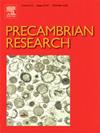Identification of the Shuanglongtan tectonic mélange (ca. 1.7–1.5 Ga) in the southwestern Yangtze Block and it’s tectonic implications
IF 3.2
2区 地球科学
Q2 GEOSCIENCES, MULTIDISCIPLINARY
引用次数: 0
Abstract
The Yangtze Block hosts large quantities of late Paleoproterozoic to early Mesoproterozoic mafic rocks, which are considered to be related to the breakup of the Nuna supercontinent. This study identified a tectonic mélange suite within the Shuanglongtan fault zone (also referred to as the Shuanglongtan tectonic mélange) in the southwestern Yangtze Block. Field observations and rock assemblages suggest there are five litho-tectonic units within the tectonic mélange: ultramafic rocks (pyroxene peridotites and picrites), mafic dikes (gabbros and diabases), meta-basalts and pelagic sediments, ocean-island basalts (OIBs) and seamount sediments (marbleized limestones), and exotic blocks (grayish-purple metasandstones and siltstones with hematite mineralization). These litho-tectonic units experienced greenschist to low amphibolite facies metamorphism, as revealed by the mylonitized and lineated structures. The zircon U-Pb dating indicates that these mafic volcanic rocks within the tectonic mélange were formed from the late Paleoproterozoic to the early Mesoproterozoic (1728 ± 27 to 1493 ± 12 Ma). These rocks, formed by the 5 %–15 % partial melting of a mantle source composed of spinel-garnet lherzolites, can be classified into enriched mid-ocean ridge basalt (E-MORB)-like and OIB-like meta-basalts based on their geochemical features. In combination with previous studies and current observations, this study proposes that the Shuanglongtan tectonic mélange emerges as the eastward extension of the Caiziyuan ophiolite mélange and that the Yangtze Block was divided into the eastern and western portions by an oceanic basin from the late Paleoproterozoic to the early Mesoproterozoic.

扬子地块西南部约1.7 ~ 1.5 Ga双龙潭构造段的识别及其构造意义
扬子地块发育大量晚古元古代至早中元古代基性岩,被认为与努纳超大陆的分裂有关。本研究在扬子地块西南部双龙潭断裂带(又称双龙潭构造孟段格)内确定了一套构造孟段格。野外观测和岩石组合表明,在构造范围内存在5个岩石构造单元:超镁质岩(辉石橄榄岩和苦荞岩)、基性岩脉(辉长岩和辉绿岩)、变质玄武岩和远洋沉积物、洋岛玄武岩(OIBs)和海山沉积物(大理石质灰岩)和外来块体(灰紫色变质砂岩和赤铁矿化粉砂岩)。这些岩石-构造单元经历了绿片岩-低角闪岩相变质作用,糜棱岩化和线状构造反映了它们的变质作用。锆石U-Pb定年结果表明,这些构造区间内的基性火山岩形成于古元古代晚期至中元古代早期(1728±27 ~ 1493±12 Ma)。这些岩石由尖晶石-石榴石-辉橄榄岩组成的地幔源5% - 15%部分熔融形成,根据其地球化学特征可分为富中洋脊玄武岩(E-MORB)型和obb型变质玄武岩。结合前人的研究和目前的观测,认为双龙潭构造为菜子园蛇绿岩的东伸,扬子地块在古元古代晚期至中元古代早期被洋盆划分为东西两部分。
本文章由计算机程序翻译,如有差异,请以英文原文为准。
求助全文
约1分钟内获得全文
求助全文
来源期刊

Precambrian Research
地学-地球科学综合
CiteScore
7.20
自引率
28.90%
发文量
325
审稿时长
12 months
期刊介绍:
Precambrian Research publishes studies on all aspects of the early stages of the composition, structure and evolution of the Earth and its planetary neighbours. With a focus on process-oriented and comparative studies, it covers, but is not restricted to, subjects such as:
(1) Chemical, biological, biochemical and cosmochemical evolution; the origin of life; the evolution of the oceans and atmosphere; the early fossil record; palaeobiology;
(2) Geochronology and isotope and elemental geochemistry;
(3) Precambrian mineral deposits;
(4) Geophysical aspects of the early Earth and Precambrian terrains;
(5) Nature, formation and evolution of the Precambrian lithosphere and mantle including magmatic, depositional, metamorphic and tectonic processes.
In addition, the editors particularly welcome integrated process-oriented studies that involve a combination of the above fields and comparative studies that demonstrate the effect of Precambrian evolution on Phanerozoic earth system processes.
Regional and localised studies of Precambrian phenomena are considered appropriate only when the detail and quality allow illustration of a wider process, or when significant gaps in basic knowledge of a particular area can be filled.
 求助内容:
求助内容: 应助结果提醒方式:
应助结果提醒方式:


